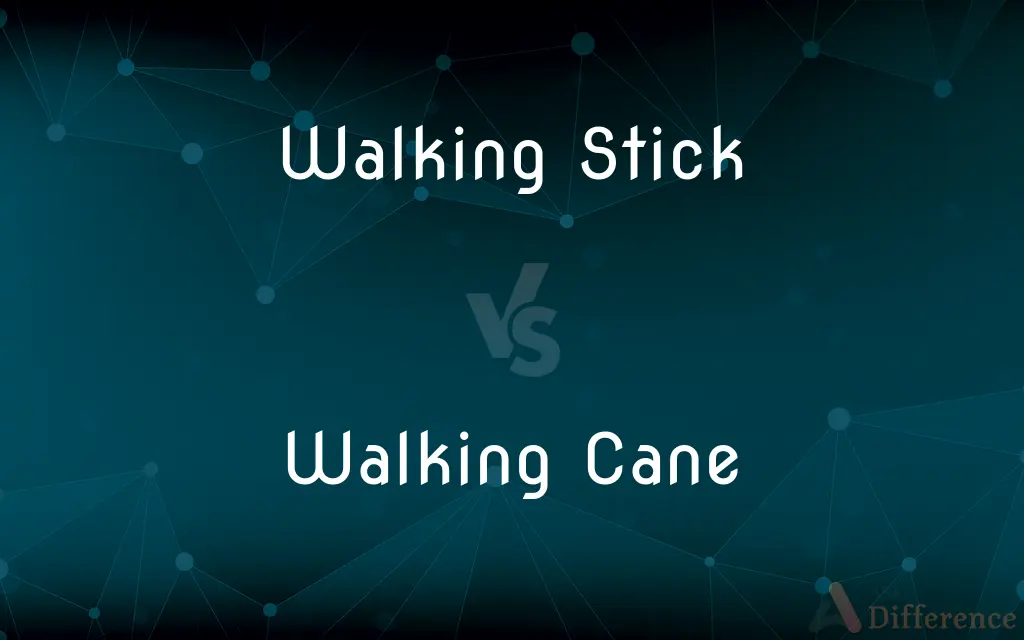Walking Stick vs. Walking Cane — What's the Difference?
By Fiza Rafique & Maham Liaqat — Published on March 6, 2024
A walking stick is primarily used for balance and support over uneven terrain, while a walking cane provides stability and weight support for everyday use.

Difference Between Walking Stick and Walking Cane
Table of Contents
ADVERTISEMENT
Key Differences
Walking sticks, often used for hiking or walking on trails, are designed to aid with balance on uneven surfaces. They can be made from various materials like wood or lightweight metals and are usually height-adjustable to suit different terrains. Walking canes, on the other hand, are crafted to offer support and stability for individuals with mobility issues, often featuring a curved or T-shaped handle for comfortable grip and sometimes a rubber tip for added traction on smooth surfaces.
The design and functionality of walking sticks and canes differ significantly. Walking sticks tend to be more rugged and functional, with some featuring pointed tips for grip in outdoor environments. Canes, however, are designed with more emphasis on ergonomic support, including features like adjustable heights and specially designed handles to reduce hand strain and improve stability.
While walking sticks are versatile and can be used by anyone seeking extra stability when engaging in outdoor activities, walking canes are specifically tailored for those with medical needs, offering support for one side of the body. This distinction is crucial for users who rely on these aids for daily activities and require the specific support that a cane provides.
The aesthetic aspect also varies, with walking sticks often showcasing natural materials and designs, reflecting a connection to nature and outdoor adventure. Canes might have a more polished look, with options available in various materials and styles to suit personal taste and comfort, sometimes even reflecting the user’s personal style or fashion sense.
Maintenance and care for these aids differ due to their construction and use. Walking sticks may require less frequent maintenance, mainly needing occasional cleaning and checks for wear on tips. Canes, especially those with more complex features like adjustable heights or foldability, may require regular adjustment, cleaning, and inspection to ensure safety and functionality.
ADVERTISEMENT
Comparison Chart
Primary Use
Balance on uneven terrain
Stability and weight support
Design
Rugged, sometimes adjustable
Ergonomic, often with a rubber tip
Handle Type
Varies, often straight
Curved or T-shaped for grip
Material
Wood, metal, etc.
Various, including lightweight metals
Target User
Outdoor enthusiasts
Individuals with mobility issues
Compare with Definitions
Walking Stick
Often made from natural materials.
His walking stick was hand-carved from a sturdy oak branch.
Walking Cane
May include adjustable height and foldability.
Her compact walking cane could be folded and stored in her bag.
Walking Stick
A tool for balance in outdoor activities.
She used a walking stick to navigate the rocky trail.
Walking Cane
Features a curved or T-shaped handle.
His walking cane had an ergonomic handle for comfortable use.
Walking Stick
Can be height-adjustable for terrain.
Adjusting her walking stick, she prepared for the steep climb.
Walking Cane
Designed for everyday stability.
The walking cane offered her the stability needed for safe movement around the house.
Walking Stick
Not specifically designed for medical use.
Walking sticks are popular among hikers for added stability.
Walking Cane
Targets individuals with specific medical needs.
Walking canes are essential for many people with mobility impairments.
Walking Stick
May have a pointed tip for outdoor surfaces.
The walking stick's pointed tip helped him maintain balance on the slippery slope.
Walking Cane
Provides support for mobility challenges.
After her surgery, she relied on a walking cane for daily walks.
Walking Stick
Alternative spelling of walking stick
Common Curiosities
Can a walking stick be used as a cane?
While possible, walking sticks aren't designed for the specific support and weight-bearing a cane provides.
How do I choose between a walking stick and a cane?
Choose based on your needs: a walking stick for balance on uneven outdoor terrains or a cane for daily support and stability.
Can walking sticks and canes be customized?
Yes, both can be customized in terms of design, material, and features to suit personal preferences and needs.
Is there a difference in weight between walking sticks and canes?
Generally, canes might be lighter and designed for easy maneuverability, while walking sticks can vary widely in weight.
How do I adjust the height of my walking cane or stick?
Many models have a button or screw mechanism for height adjustment; consult the manufacturer’s instructions for specifics.
Are walking canes suitable for hiking?
Canes are not ideal for hiking due to their design for smooth surfaces and specific support needs.
What materials are walking sticks made from?
They can be made from wood, aluminum, and other lightweight metals, depending on the intended use and design.
How often should I replace my walking cane?
Replace your cane if it shows significant wear, damage, or if your medical needs change.
Are there walking canes designed for specific medical conditions?
Yes, canes can be specially designed for various conditions, including arthritis, with features like ergonomic handles.
What maintenance does a walking stick require?
Maintenance mainly involves cleaning and checking for damage, especially on the tip and any adjustable parts.
Can I take a walking cane on an airplane?
Yes, walking canes are generally allowed on airplanes but check with the airline for any specific regulations.
Share Your Discovery

Previous Comparison
Cream vs. Whipping Cream
Next Comparison
Acetone vs. Acetic AcidAuthor Spotlight
Written by
Fiza RafiqueFiza Rafique is a skilled content writer at AskDifference.com, where she meticulously refines and enhances written pieces. Drawing from her vast editorial expertise, Fiza ensures clarity, accuracy, and precision in every article. Passionate about language, she continually seeks to elevate the quality of content for readers worldwide.
Co-written by
Maham Liaqat















































